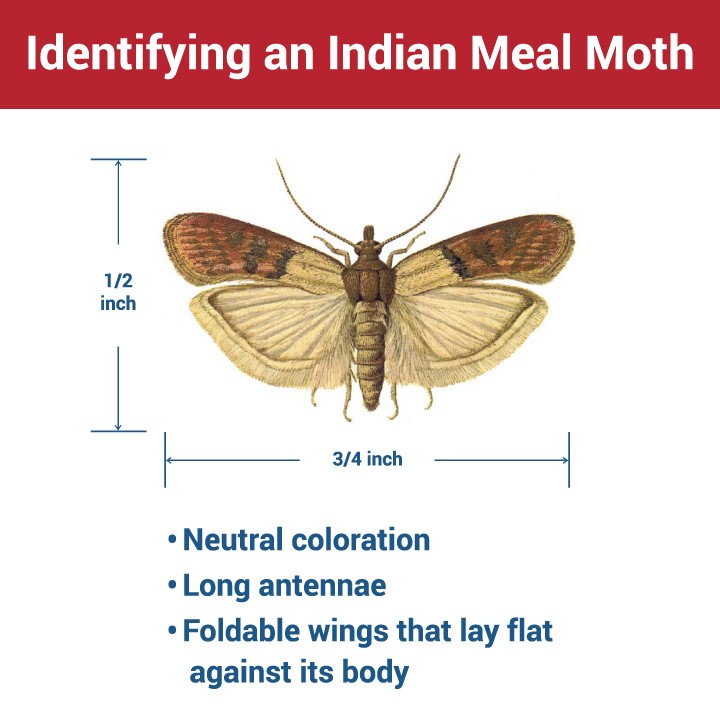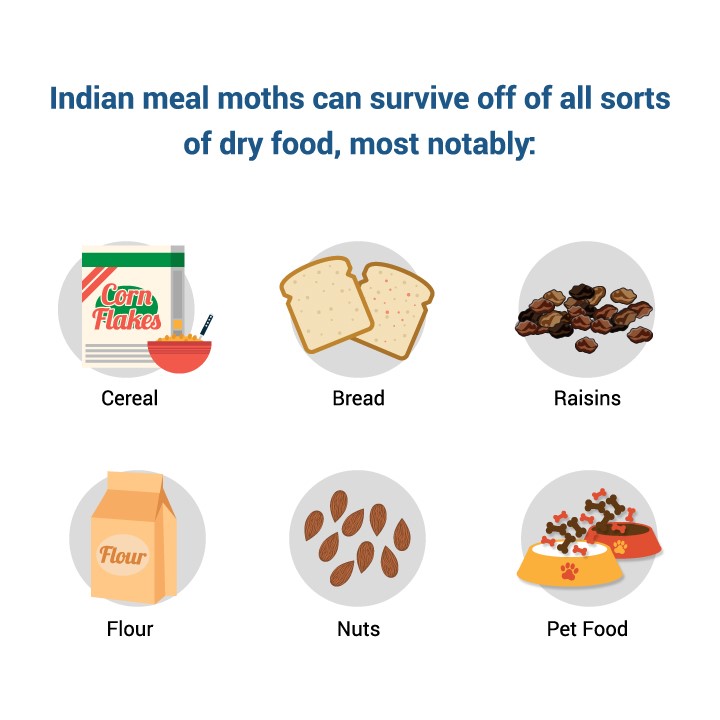When you think of pests, you likely conjure images of spindly spiders, aggressive wasps, or disease-infested rats. Frightening pests like these have monopolized the term thanks to a scary demeanor, painful bites or stings, and an overall bad reputation. However, often overlooked, moths also represent a threat. Commercially, Indian meal moths present an issue that takes more than a few mothballs to solve.
There is a subset of the “moth” family known to ransack food storage. And while many think they only invade pantries inside homes, that’s not the case at all. Many businesses have a higher risk of encountering this pest, including grocery stores, food processing plants, grain storage facilities, and more. So, if you have a supply of stored food in your warehouse, read on about the Indian meal moth.
What Are Indian Meal Moths?
The Indian meal moth is a small, winged insect that requires your food for nearly every phase of their life: typically, between 30 and 300 days. You may have heard them referred to as a weevil, pantry, flour, or grain moth due to its preferred food types. In fact, its actual name originated the same way – back when cornmeal was referred to as Indian meal.
These insects vary in length, up to about a half-inch long, with a wingspan up to ¾ of an inch. With two sets of wings, the anterior set has a brownish edge and a yellowish-gray center. The second set of wings resembles parchment paper. Because this set also folds underneath the first, it’s textured like a paper fan.

Female moths lay between 60 and 400 eggs on a food surface, which hatch in only two to 17 days. The eggs usually resemble the beads you’d find in a silica gel packet, but with an opaque white tint. After hatching, the moth enters the larvae stage with the following characteristics:
- Off-white colored, with brown heads
- Just under a half-inch when matured
- Complete with five pairs of well-developed legs to move a considerable distance.
The larval stage lasts two to 41 weeks, depending on the temperature and access to food. After that, the moth endures its pupa, or cocoon, cycle as it turns into an adult.
Indian meal moths are most active at night, so you may not notice an infestation when it begins. In fact, you’re not likely to assume they’re Indian meal moths at first anyway because you’ll often see them away from the food source. Like most insects, these moths are attracted to light and will fly toward it. While they’re flying, you might notice them going in a zig-zag pattern.
How They Invade
The Indian meal moth can infest many different dry foods. They’re particularly attracted to foods of vegetable origin, seeds, and different powders like cocoa, spices, flour, rice, and other grains.

From sweets like dried fruit and cereal to more savory spices, pasta, or coffee, Indian meal moths are not picky eaters. But they are hungry – they go as far as chewing through plastic and cardboard packaging to get into food.
Often originating from food shipments, Indian meal moth infestations are pretty noticeable despite their small size. If you see adult Indian meal moths, cast skins and droppings, or silk-like webbing over food products, you likely have an infestation. Our experts at Sprague Pest Solutions can perform a professional inspection to confirm a pest infestation and identify high-risk areas that require treatment.
Negative Impact on Businesses
Because they can lay up to 400 eggs at a time, Indian meal moths can spread fast. Couple that with their ability to go great distances and you can’t rule out products on the other side of the warehouse or store. Even products that you think are tightly sealed could be at risk since these moths are known to chew through unopened packages. The larva can climb on ceilings and into obscure nooks to spin their cocoons and hatch later on. Their widespread infestations and sneaky behaviors make getting rid of them notoriously hard. Once they’re found, they require diligence, patience, and experience to get rid of.
Unlike bed bugs, rodents, or carpenter ants, Indian meal moths do not present hazardous health risks or cause structural and cosmetic damage. But they do leave behind feces, shed skin, and other debris. They are inherently unhygienic and pose a threat to your reputation. From a customer accidentally purchasing an infested food item to the vast loss of inventory or production capabilities, for infested equipment, you should know how to manage this pest in your business.
How Do You Get Rid of Indian Meal Moths?
While prevention is virtually impossible, FIFO inventory management and the use of plastic bins are more likely to deter infestations. You should take care to clean up food spills promptly and regularly inspect foods to catch a pest outbreak before it spreads.
At Sprague Pest Solutions, we can put your Indian meal moth troubles behind you using pheromone monitoring and mating disruption treatments. Mating disruption traps the male insects and halts the rapid reproduction cycle. While mating disruption pheromone lures need to be maintained over several services to complete, we are committed to ensuring your satisfaction. Once the insects are gone, we can perform pheromone monitoring to identify high-risk seasonality and prevent another outbreak.
Trust Sprague as Your Stored Pest Solution
Indian meal moths don’t have spindly legs or long wiry tails, but they are a pest that has a high potential for damage nonetheless. With risks to your production, inventory, and bottom line, commercial businesses with stored food need a partner they can trust when dealing with this far-reaching pest. While handling some moths is as simple as throwing moth balls into your dresser, Indian meal moths are more difficult to eradicate. But, the solution is simple: Let Sprague manage your Indian meal moth problems. Contact us to protect your business and your customers from Indian meal moths and other stored food pests today.

